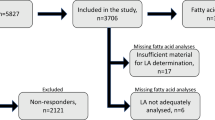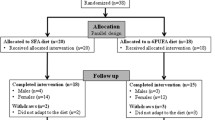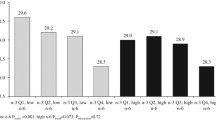Abstract
Dietary and plasma fatty acids have been linked to total cholesterol but not to the ratio of total/high-density lipoprotein cholesterol (TC/HDLC). To evaluate the relationship between dietary and plasma levels of polyunsaturated fatty acids (PUFA) and TC/HDLC, we analyzed cross-sectional and longitudinal data using 519 plasma samples (50% men, 50% women) from subjects participating in the Framingham Heart Study and results from a study feeding diets rich in either n-6 linoleic acid or n-3 α-linolenic acid with or without fish oil supplements (n-3 derivatives). Values of TC/HDLC are inversely related to the percent of plasma PUFA when both variables are measured at the same time in different subjects,R=0.82,P<0.000001. PUFA in phospholipids increase in response to increased dietary intake of different PUFA, either n-3 or n-6 or fish oils. There was a highly significant inverse relationship between TC/HDLC and the percent of PUFA in phospholipids,R=0.97,P<0.001. The relationship was similar regardless of the source and type of dietary fatty acids. A similar relationship existed when only the baseline points were considered. When plasma PUFA % increases, either in response to a diet high in PUFA or across different subjects, TC/HDLC ratios decline. Evaluation of plasma fatty acid profiles and increased balanced dietary intake of PUFA to bring fatty acid profiles of subjects with low PUFA plasma levels closer to the profile of a healthy reference group is an effective approach to reduce high TC/HDLC. Reductions of more than 50% in TC/HDLC appear feasible with dietary modification alone. Further research into fatty acid metabolic activity may determine the biochemical basis of common dysplipidemias.
Similar content being viewed by others
Abbreviations
- ALA:
-
α-linolenic acid
- EFA:
-
essential fatty acids
- EFAD:
-
essential fatty acid deficiency
- EFAI:
-
essential fatty, acid insufficiency
- LA:
-
linoleic acid
- PUFA:
-
polyunsaturated fatty acids
- TC/HDLC:
-
total/high density lipoprotein cholesterol.
References
Harris, W.S. (1989) Fish Oils and Plasma Lipid and Lipoprotein Metabolism in Humans: A Critical Review,J. Lipid Res. 30, 785–807.
Horrobin, D.F., and Manku, M.S. (1983) How Do Polyunsaturated Fatty Acids Lower Plasma Cholesterol Levels?,Lipids 18, 558–562.
Warren, S.E., Siguel, E.N., Gervino, E., Salzman, E.W., Smith, M., Silverman, K.J., and Pasternak, R.C. (1988) Effects of Cod Liver Oil On Plasma Lipids, Eicosanoids, Platelet Aggregation, and Exercise in Stable Angina Pectoris,J. Applied Cardiol. 3, 227–236.
Superko, H.R., and Krauss, R.M. (1994) Coronary Artery Disease Regression. Convincing Evidence for the Benefit of Agressive Lipoprotein Management,Circulation 90, 1056–1069.
Paterson, R.W., Paat, J.J., Steele, G.H., Hathaway, S.C., and Wong, J.G. (1994) Impact of Intensive Lipid Modulation on Angiographically Defined Coronary Disease: Clinical Implications,South. Med. J. 87, 236–242.
Kingsbury, K.J., Brett, C., Stovold, R., Chapman, A., Anderson, J., and Morgan, D.M. (1974) Abnormal Fatty Acid Composition and Human Atherosclerosis,Postgrad. Med. J., 50, 425–440.
Kingsbury, K.J. (1970) Polyunsaturated Fatty Acids and Myocardial Infarction,Lancet i, 648–676.
Miettinen, T.A., Naukkarinen, V., Huttunen, J.K., Mattila, S., and Kumlin, T. (1982) Fatty Acid Composition of Serum Lipids Predicts Myocardial Infarction,Br. Med. J. 285, 993–996.
Simpson, H.C.R., Barker, K., Carter, R.D., Cassels, E., and Mann, J.I. (1982) Low Dietary Intake of Linoleic Acid Predisposes to Myocardial Infarction,Br. Med. J. 285, 683–687.
Valek, J., Hammer, J., Kohout, M., Grafnetter, D., Vondra, K., and Topinka, V. (1985) Serum Linoleic Acid and Cardiovascular Death in Postinfarction Middle-Aged Men,Atherosclerosis 54, 111–118.
Luostarinen, R., Boberg, M., and Saldeen, T. (1993) Fatty Acid Composition in Total Phospholipids of Human Coronary Arteries in Sudden Cardiac Death,Atherosclerosis 99, 187–193.
Siguel, E.N., and Lerman, R.H. (1994) Fatty Acid Patterns in Patients with Angiographically Documented Coronary Artery Disease,Metabolism 43, 982–993.
Mantzioris, E., James, M.J., Gibson, R.A., and Cleland, L.G. (1994) Dietary Substitution with an Alpha-Linolenic Acid-Rich Vegetable Oil Increases Eicosapentaenoic Acid Concentrations in Tissues.Am. J. Clin. Nutr. 59, 1304–1309.
Siguel, E.N., and Maclure, M. (1987) Relative Enzyme Activity of Unsaturated Fatty Acid Metabolic Pathways in Humans,Metabolism 36, 664–669.
Holman, R.T., Smythe, L., and Johnson, S. (1979) Effect of Sex and Age on Fatty Acid Composition of Human Serum Lipids,Am. J. Clin. Nutr. 32, 2390–2399.
Lepage, G., and Roy, C.C. (1986) Direct Transesterification of All Classes of Lipids in a One-Step Reaction,J. Lipid Res. 27, 1114–1120.
Siguel, E.N., Method And Apparatus for Diagnosis of Fatty Acid or Lipid Abnormalities, U.S. Patent No. 5075101.
Siguel, E.N., Chee, K.M., Gong, J., and Schaefer, E.J. (1987) Criteria for Essential Fatty Acid Deficiency in Plasma as Assessed by Capillary Column Gas-Liquid Chromatography,Clin. Chem. 33, 1869–1873.
Gronn, M., Gorbitz, C., Christensen, E., Levorsen, A., Ose, L., Hagve, T.A., and Christophersen, B.O. (1991) Dietary N-6 Fatty Acids Inhibit the Incorporation of Dietary N-3 Fatty Acids in Thrombocyte and Serum Phospholipids in Humans: A Controlled Dietetic Study,Scand. J. Clin. Lab. Invest. 51, 255–263.
Garcia, J., Ghisolfi, J., Lapalu-Traon, C., Periquet, B., Olives, J.P., Boyer, M.J., and Thowenot, J.P. (1986) Screening for Essential Fatty Acid Deficiency in the Infant,Ann. Biol. Clin. 44, 380–383.
Siguel, E.N. (1994) Essential andtrans Fatty Acid Metabolism in Health and Disease. Nutrition Issue,Contemporary Therapy 20(9), 500–510.
Siguel, E.N. (1994)Essential Fatty Acids in Health and Disease, Nutrek Press, Brookline, MA.
Siguel, E.N., and Lerman, R.H. (1996) Fatty Acid Patterns in Patients with Gastrointestinal Disease,Metabolism, in press.
Sinclair, H. (1980) Dietary Fats and Coronary Heart Disease. Controversy,Lancet i, 414–415.
Nash, M.J., Is a Low-Fat Diet Risky? (1994)Time magazine, September 5, p. 62.
Siguel, E.N., and Lerman, R.H. (1995) The Role of Essential Fatty Acids: Reply to the USDA,Am. J. Clin. Nutr. 63, 973–979.
Siguel, E.N., and Lerman, R.H. (1994) The Role of Essential Fatty Acids: Dangers in the USDA Dietary Recommendations (Pyramid) and in Low Fat Diets,Am. J. Clin. Nutr. 60, 973–979.
Schaefer, E.J., Lichtestein, A.H., and Lamon-Fava, S.L. (1995) Body Weight and Low Density Lipoprotein Cholesterol Changes After Consumption of a Low-Fat Ad Libitum Diet,JAMA 274, 1450–1455.
Leaf, A., and Weber, P.C. (1988) Cardiovascular Effects of n-3 Fatty Acids,N. Eng. J. Med. 318, 549–557.
Horrobin, D.F., (ed.) (1990)Omega-6 Essential Fatty Acids. Pathophysiology and Roles in Clnical Medicine, Wiley-Liss, New York.
Lands, W.E.M., Libelt, B., Morris, A., Kramer, N.C., Prewitt, T.E., Bower, P., Schmeisser, D., Davidson, M.Y.H., and Burns, J.H. (1992) Maintenance of Lower Proportions of (n-6) Eicosanoid Precursors in Phospholipids of Human Plasma in Response to Added Dietary (n-3) Fatty Acids,Biochim. et Biophys. Acta 1180, 147–162.
American Heart Association, Introductory statement in the announcement for the Scientific Conference on the Efficacy of Hypocholesterolemic Dietary Interventions, San Antonio, TX.
Siscovick, D.S., Raghunathan, T.E., and King, I. (1995) Dietary Intake and Cell Membrane Levels of Long-Chain n-3 Polyunsaturated Fatty Acids and the Risk of Primary Cardiac Arrest,JAMA 274, 1363–1367.
Author information
Authors and Affiliations
About this article
Cite this article
Siguel, E. A new relationship between total/high density lipoprotein cholesterol and polyunsaturated fatty acids. Lipids 31, S51–S56 (1996). https://doi.org/10.1007/BF02637051
Issue Date:
DOI: https://doi.org/10.1007/BF02637051




